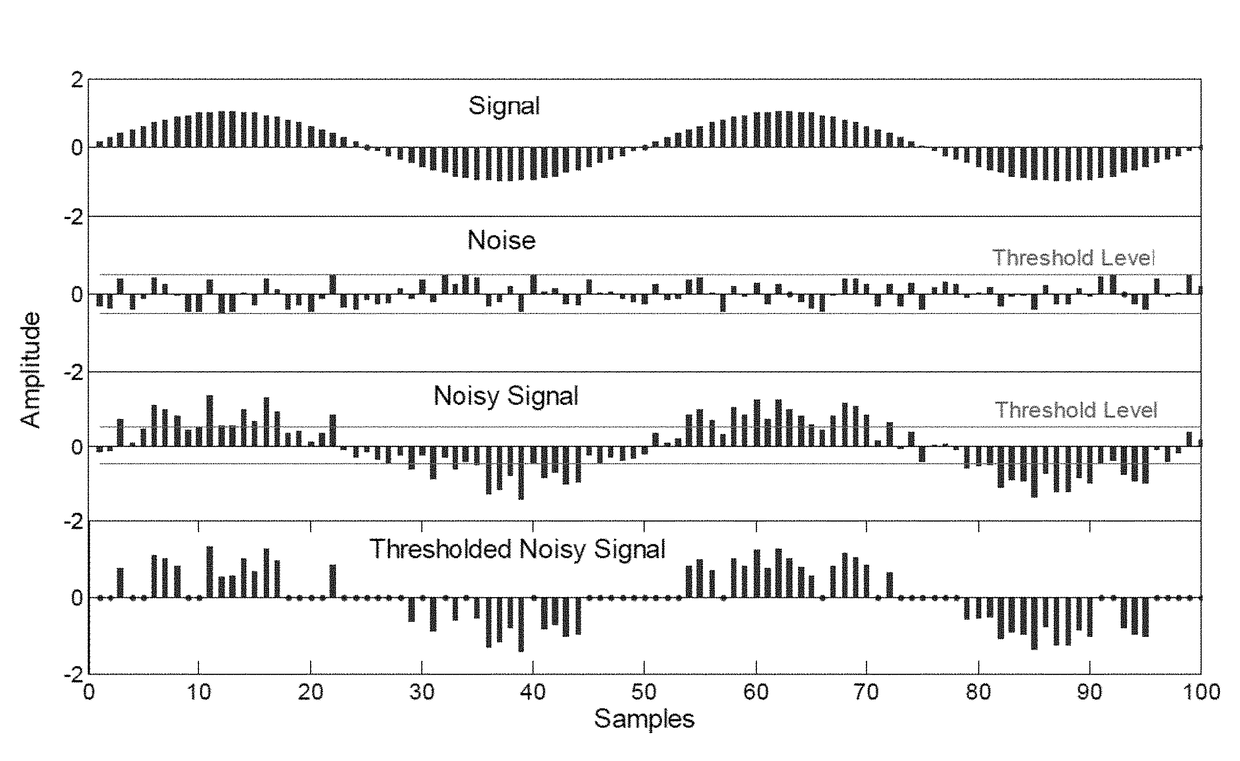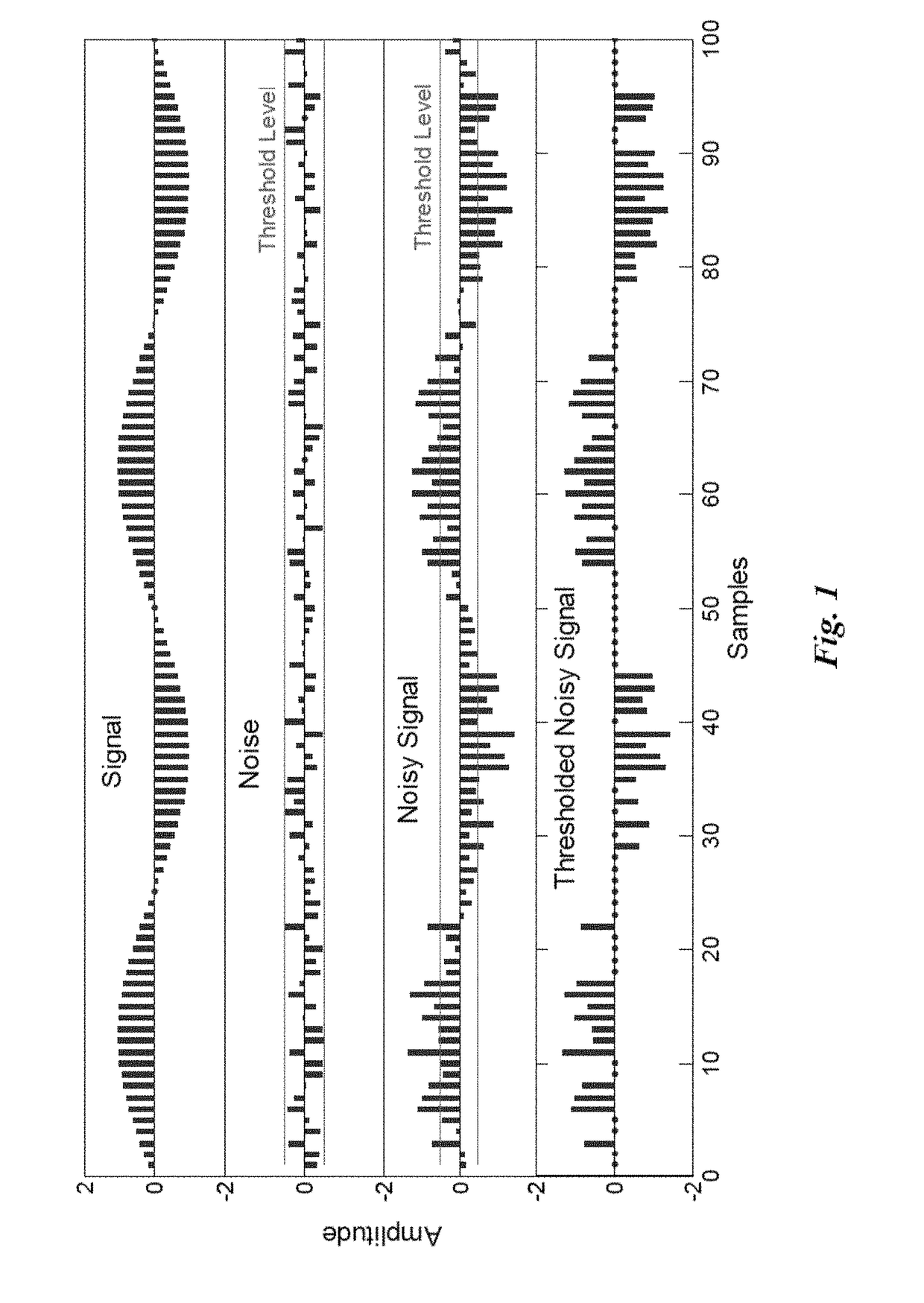Method and system for multi-talker babble noise reduction
a multi-talker, noise-reducing technology, applied in the field of methods and systems for noise reduction, can solve the problem that the previous audio signal frame may include predominantly noise, and achieve the effect of improving user intelligibility
- Summary
- Abstract
- Description
- Claims
- Application Information
AI Technical Summary
Benefits of technology
Problems solved by technology
Method used
Image
Examples
example i
[0194]The exemplary embodiment of FIG. 2a, as described above may be evaluated by measuring a subject's understanding of IEEE standard sentences with and without processing by the exemplary method 100. Sentences may be presented against a background of 6-talker babble using four different signal to noise ratios (0, 3, 6, or 9 dB). In IEEE standard sentences (also known as “1965 Revised List of Phonetically Balanced Sentences, Harvard Sentences) there may be 72 lists of 10 sentences. To test speech intelligibility in noise, two randomly selected sentence sets (20 sentences) may be presented for each of the following 8 conditions:
[0195]1-Speech and 6 Talker Babble (SNR=0 dB)—Unprocessed
[0196]2-Speech and 6 Talker Babble (SNR=0 dB)—Processed
[0197]3-Speech and 6 Talker Babble (SNR=3 dB)—Unprocessed
[0198]4-Speech and 6 Talker Babble (SNR=3 dB)—Processed
[0199]5-Speech and 6 Talker Babble (SNR=6 dB)—Unprocessed
[0200]6-Speech and 6 Talker Babble (SNR=6 dB)—Processed
[0201]7-Speech and 6 Talk...
example ii
[0213]The exemplary embodiment of FIG. 2b, as described above may be evaluated by measuring a subject's understanding of IEEE standard sentences with and without processing by the exemplary method 150. All babble samples in Example II are randomly created by mixing sentences randomly taken from a pool of standard sentences which contains a total of 2,100 sentences (including IEEE standard sentences with male and female speaker, Hint sentences and SPIN sentences). For each babble sample, the number of talkers was randomized between 5 to 10 and the gender ratio of talkers also was randomly selected (all female, all male or a random combination of both.)
[0214]FIG. 10 shows a Gaussian Mixture model using EM method trained with EM method trained with 100,000 randomly created noisy speech samples with SNRs ranging from −10 dB to 20 dB, as the different speech samples would be classified under step 152. A first set of curves to the right curves represent Gaussian distributions belonging to...
example iii
[0224]As discussed above, the exemplary method 300 provides a babble noise reduction method (e.g., a SEDA-RT) that solves the ineffectiveness of simple temporal / spectral thresholding. Example III, as described herein, provide a detailed description of an exemplary embodiment of the three stages of exemplary method 300 (e.g., SEDA-RT), methods for clinical testing of the exemplary method, and collected data from CI users using SEDA-RT. In addition, the speed and latency of the exemplary embodiment of method 300 are measured using different computing machines (e.g., cell phones, tablets, and computers).
1. Classification
[0225]In step 304, each frame of an input signal may be classified into a first category corresponding to the noise being stronger than the speech signal, or a second category corresponding to the speech signal being stronger than the noise. In particular, the exemplary method 300 may utilize a classifier which is capable of classifying the relatively short frames of th...
PUM
 Login to View More
Login to View More Abstract
Description
Claims
Application Information
 Login to View More
Login to View More - R&D
- Intellectual Property
- Life Sciences
- Materials
- Tech Scout
- Unparalleled Data Quality
- Higher Quality Content
- 60% Fewer Hallucinations
Browse by: Latest US Patents, China's latest patents, Technical Efficacy Thesaurus, Application Domain, Technology Topic, Popular Technical Reports.
© 2025 PatSnap. All rights reserved.Legal|Privacy policy|Modern Slavery Act Transparency Statement|Sitemap|About US| Contact US: help@patsnap.com



